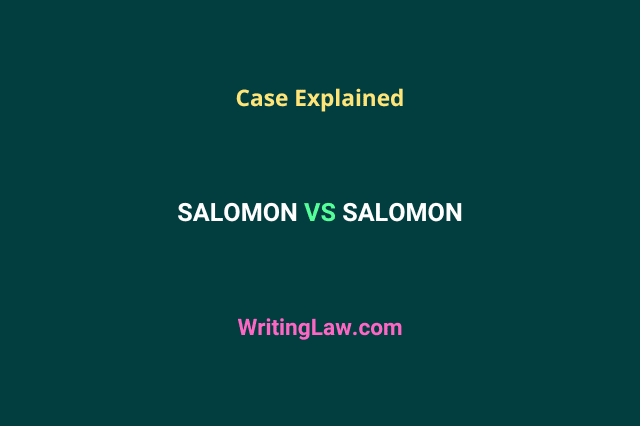
Salomon vs Salomon & Co. Ltd
(1897) A.C. 22, [1896] UKHL 1
In this case law explanation, you will read about the famous case of Salomon vs Salomon, which is essential to understand company law.
Introduction
Every company has its own identity — a separate legal personality (SLP), and this aspect of a company is a very important and fundamental element of company law.
It is regarded as the most comprehensive and consistent law of corporate jurisprudence since it lays the groundwork for the creation and operation of a company.
On the other hand, the rule of “SLP” has traditionally been fraught with controversy and is one of the subjects of dispute both inside and across jurisdictions.
The concept, established in the case of Salomon vs Salomon, is still widely used and is traditionally praised as the framework of both English company law and the entire system of international commercial law.
Facts of the Case
For many years, Aron Salomon successfully ran a profitable leather business. He decided to change it into a limited company in 1892. At that point, Salomon & Co. Ltd. was established with Salomon as the managing director, along with his wife, daughter, four sons, and wife as members.
For £39,000, the corporation bought Salomon’s business. A charge over all of the company’s assets totalling £10,000 in debentures, £20,000 in fully paid up £1 shares, and the remaining £20,000 in cash were used to pay the purchase price. Salomon possessed 20,001 out of the 20,007 shares issued, and a family member held each of the other six shares.
The business had problems almost immediately, and a year later, the holder of the debentures (Salomon having sold his shares to another party) hired a receiver, and the business entered liquidation.
At the time of liquidation, the value of the assets was divided as follows: liabilities received £6,000 (six thousand pounds), debentures received £10,000, and unsecured obligations received £7,000. Nothing would be left over for the unsecured creditors once the debenture holders had been paid.
As a result, the liquidator filed a lawsuit against Salomon, holding him responsible for covering the company’s trade debts.
Issues
- Whether Salomon & Co. Ltd. indeed existed as a company?
- Whether the company, an artificial invention of the law, had actually been properly constituted under any circumstances.
- Whether Salomon was accountable for the business’s debts?
Arguments Brought Before the Court
Salomon & Co. Ltd. was formed under the Act, but according to the liquidator, the business never existed independently. Salomon became the undisputed king due to the large majority of shares. The firm was fake, and the business was run exclusively for and by him.
Judgement
According to the House of Lords, in order to answer the question, it is required to examine the legislation itself without altering or adding to its provisions. The legislation itself must be the entire reference point.
In this instance, the Act stated that any seven or more people who are connected for a legitimate purpose may create a company with or without limited liability by signing their names to a memorandum of association and otherwise complying with the Act’s registration requirements.
Additionally, the Act stated that “no subscriber shall take less than one share.” There was no question that seven genuine living people owned the company’s shares. The court determined that the firm had been legitimately created and was an actual corporation (company) since it complied with the Act’s criteria.
House of Lords held that the provisions of the Act did not require that the people subscribing shall not be related to each other or that owning a single share shall not afford a sufficient qualification for membership, rejecting the liquidator’s argument that Salomon and his family members purchased all the shares and that the company was nothing more than a one-man show.
A creditor of the firm is unconcerned whether the company’s capital is owned by seven people in equal shares, each of whom has the right to an equivalent portion of the earnings, or if it is nearly entirely owned by one person, who gets almost all of the profits.
If one individual controls most of the firm’s capital, the company does not lose its identity. The company in question and its subscribers are entirely different people. The House of Lords also claimed that nothing in the Act required the subscribers to be independent, have a say in a significant amount of the undertaking, or have their own free will.
Conclusion
After this incident, the idea of removing the corporate veil was developed so that no one could commit fraud and escape responsibility by hiding behind the company’s organisation.
There should be some possibilities for applying this idea of lifting the corporate veil. Since a charge secured Aron Salomon’s debt against the company’s assets, it was determined in this case that he had committed no fraudulent or unlawful acts and was the company’s legitimate creditor. As a result, he had a right to be paid at the company’s winding up before any unsecured creditors.
- 13 Characteristics of a Company Under the Companies Act - 5th March 2024
- Lee vs Lee’s Air Farming Ltd – Case Explained - 5th March 2024
- Relevant Facts Under the Indian Evidence Act - 14th January 2024







